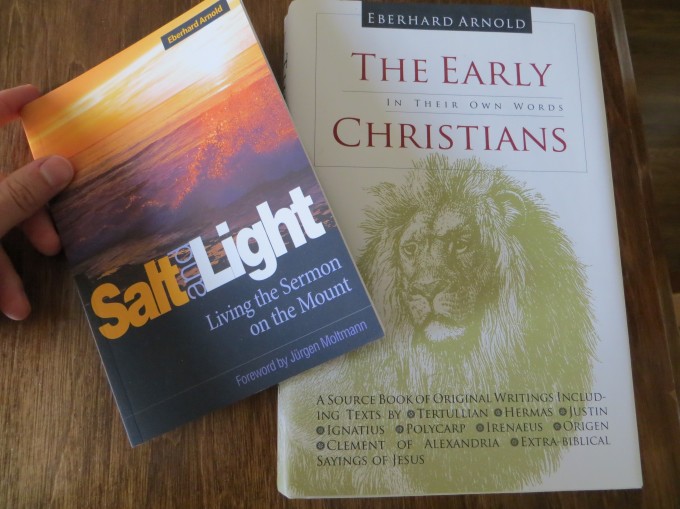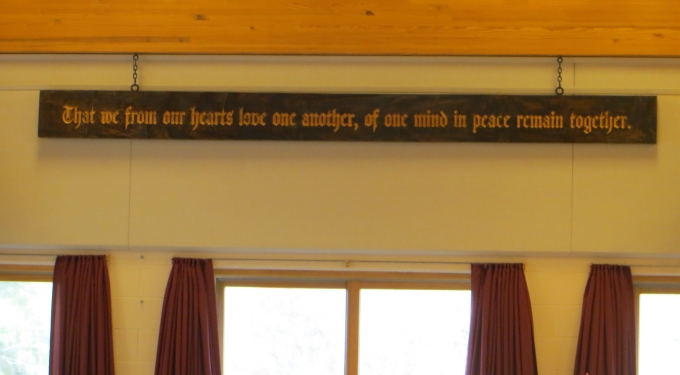Thursday, October 25th
My first full day on the Bruderhof began with my alarm at 5:40am. Perhaps that sounds early, but I had actually let myself sleep in as long as I dared, to still have enough time to get ready for breakfast with the other singles here. But people of all ages at the bruderhof seem be up and ready to face the world by 6am here.
“Don’t miss the harvest moon in the West and the pink clouds in the east,” I overheard a man down the hall calling to his wife as he headed out to his work position for the day. How precious, I thought, was it that even in their highly structured and filled days, people here seem to retain a child-like awe for and interaction with the beauty of God’s creation. I felt privileged to get a glimpse into this couple’s sweet exchange. …And of course, had to go look outside myself to see the wonder that was spoken of.
It’s interesting. With only a door (and doors are often left open here) separating my little room from the hallway where the kitchen and everybody else’s living spaces are attached, it feels like I am sharing a home and life with not one, but three other families here!
The day’s activities
After breakfast with other young people, I was given a bit of a break before joining in on kitchen work at 9am. At 10am, Julie, another new girl friend, and I stole away to the laundry room to sort some clothes for the community (and got to linger and enjoy tea and muffins -and conversation- together, which was perfectly lovely) before heading back to the kitchen work. And this kitchen – wow. Though the place had the cozy community feel of a church kitchen, it was set up to efficiently feed 200 people. Vast pots and tall ovens, and massive bread kneaders. Walk-in freezers and refrigerators larger than I’d ever seen before -storing a lot of their own home-grown produce, too.
Julie and I helped ourselves to some community meal leftovers before she showed me more around the settlement. I was taken to their headquarters for the Plough Quarterly magazine. A woman introduced me all around the office, and brought me through Plough Publishing’s library of books, even gifting me with several from the movement’s founders, and lending me a book on early christian writings until the end of my stay. (How I would find the time to read it with how full the days seem to be here, I didn’t know. But still I was intrigued enough to try to scan it through.)

Then Julie took me to another building – the community toy shop and handicap equipment factory. There, I spent the afternoon helping to stuff furniture cushions alongside several (quite) older women who were sewing the cushions together. I loved how even the elderly in the community were present in the toy shop. There was work of all types to do, and all ages beyond highschool were bustling about the place. I was told that it was common for the elderly to continue to visit the shop to contribute in what ways they could. How neat to not have to give up that sense of accomplishment that comes from putting in a day’s work – even as old age brings on more limitations. The elderly here at the Bruderhof have so many ways to keep on participating in community life. Isolation in old age is a foreign concept here, where the elderly are highly valued and respected and included and honored and cared for -well.

The footpath winding through the community buildings. (No cars were needed for most daily life, but go-carts were a common sight -for the elderly.)
Caring well for one another
Another way that I’ve observed people are cared for so well here is how the communities will relocate families or individuals to be near someone if they are sick. Or in the case of the elderly, they are often given ‘apartments’ on the ground level, while family are moved into housing above them or with them as becomes necessary. But the idea of the elderly being secluded and separated into homes.
Dinner and visiting
After a quick rest, I joined Julie and the whole community for a delicious dinner in the main gathering hall. I found it interesting that the young men in the community took turns each night bringing the food out and serving the whole community. It was a nice change, since it seemed that it was only the women who manned the kitchens and took care of putting the big community meals together.
After dinner is visiting time! Julie and I visited a very interesting older couple. Also joining us was an older woman who had been with the community since its beginnings in Germany. When the Nazis forced them to leave in 1937, she lived through the community’s brief transition to England, until persecution and suspicion of their non-resistance and many German members forced them to find refuge in Paraguay for 20 years. So neat how this one elderly lady could tell the story of the whole movement!
~ ~ ~ ~ ~ ~ ~ ~ ~ ~ ~ ~ ~ ~ ~ ~ ~ ~ ~ ~ ~ ~ ~ ~ ~ ~ ~ ~
Another day is over, but it feels like two, with all that we fit into it. Despite the new reading material, I’m learning to value an early lights out over my introverted reading and decompressing time. I’ve been invited to (a comparatively late) breakfast with another friendly couple at 6:30 tomorrow morning.




